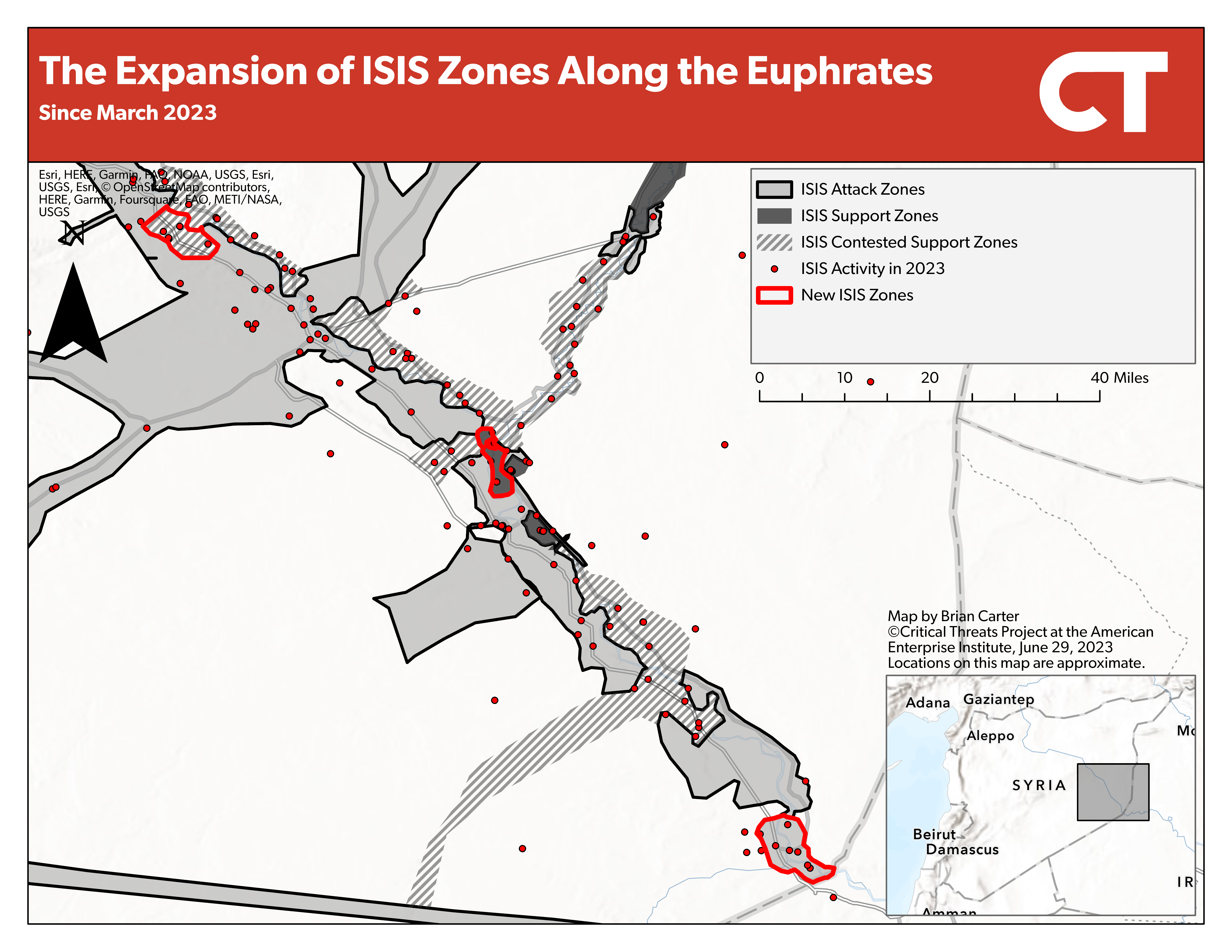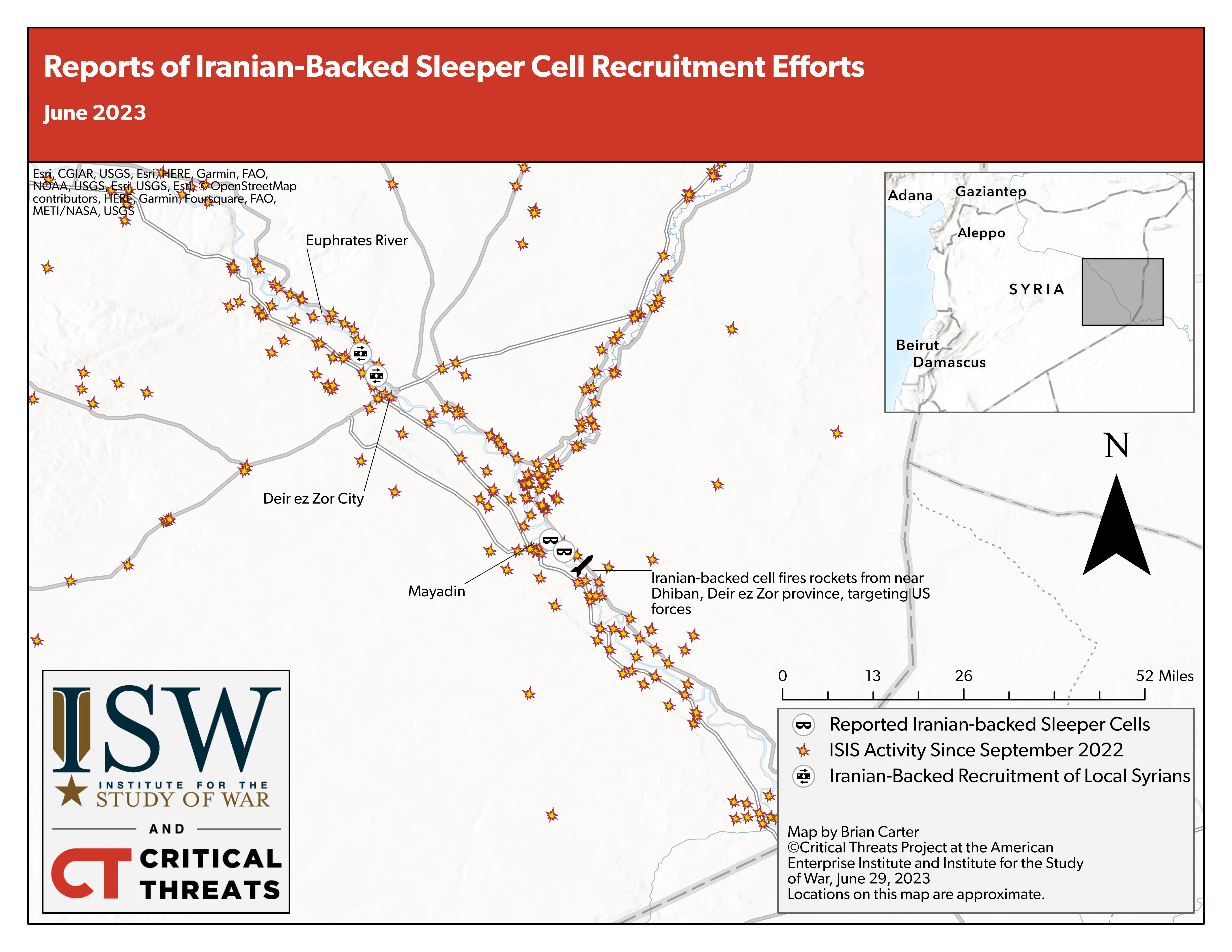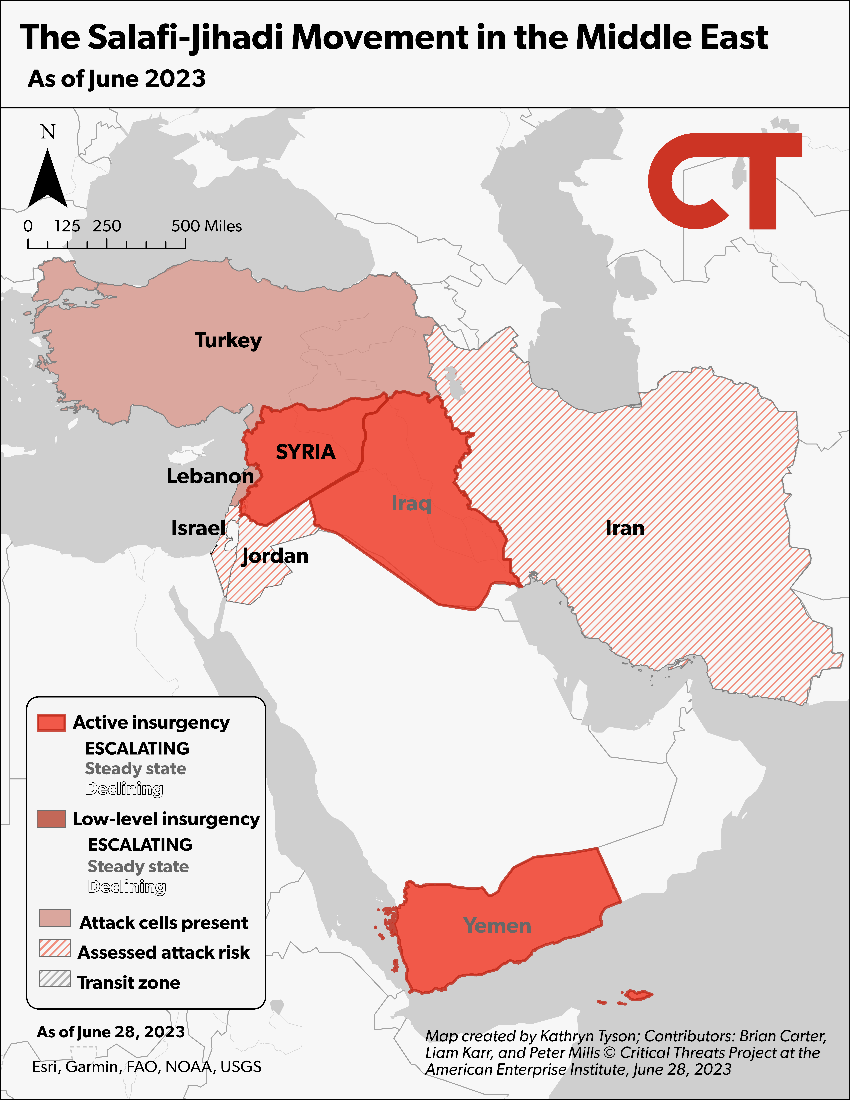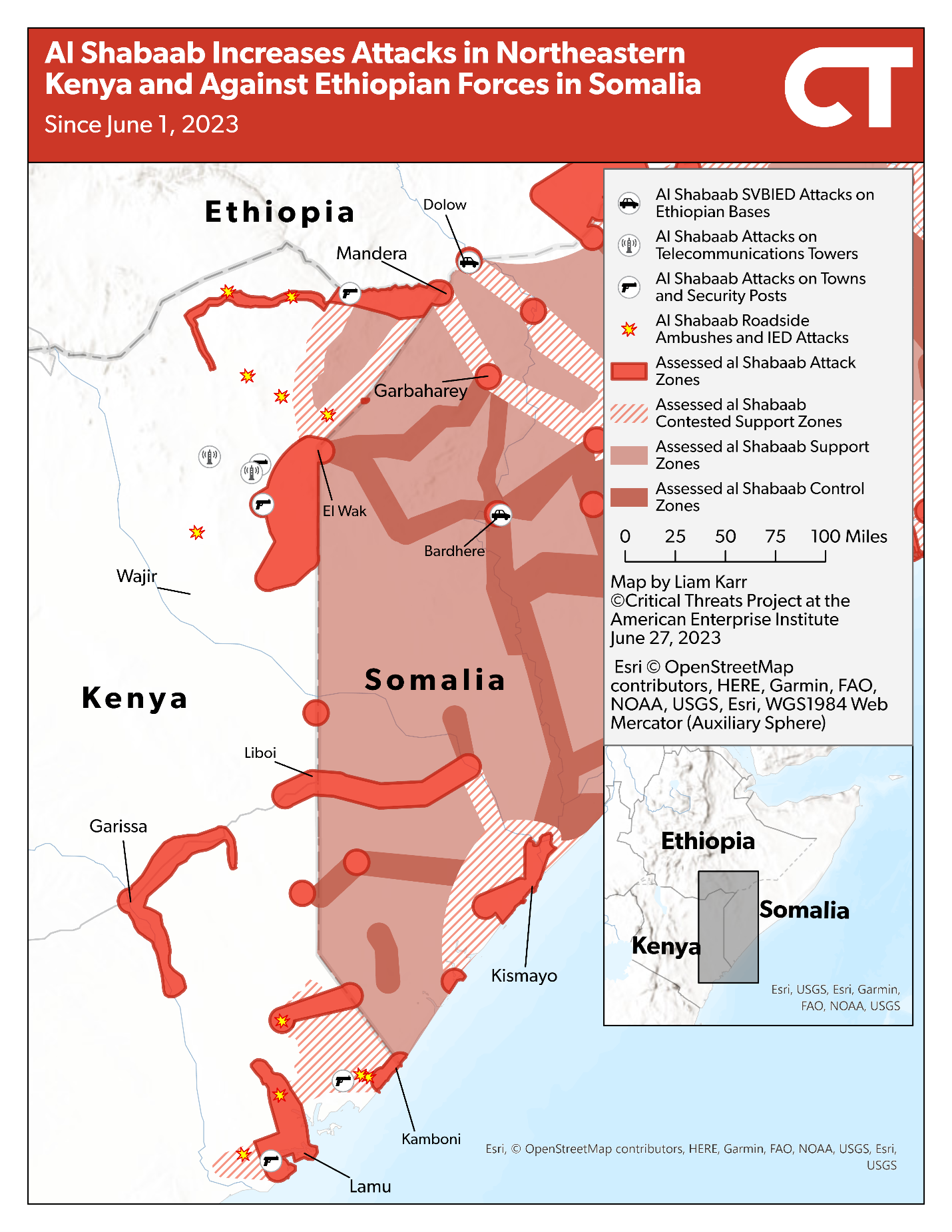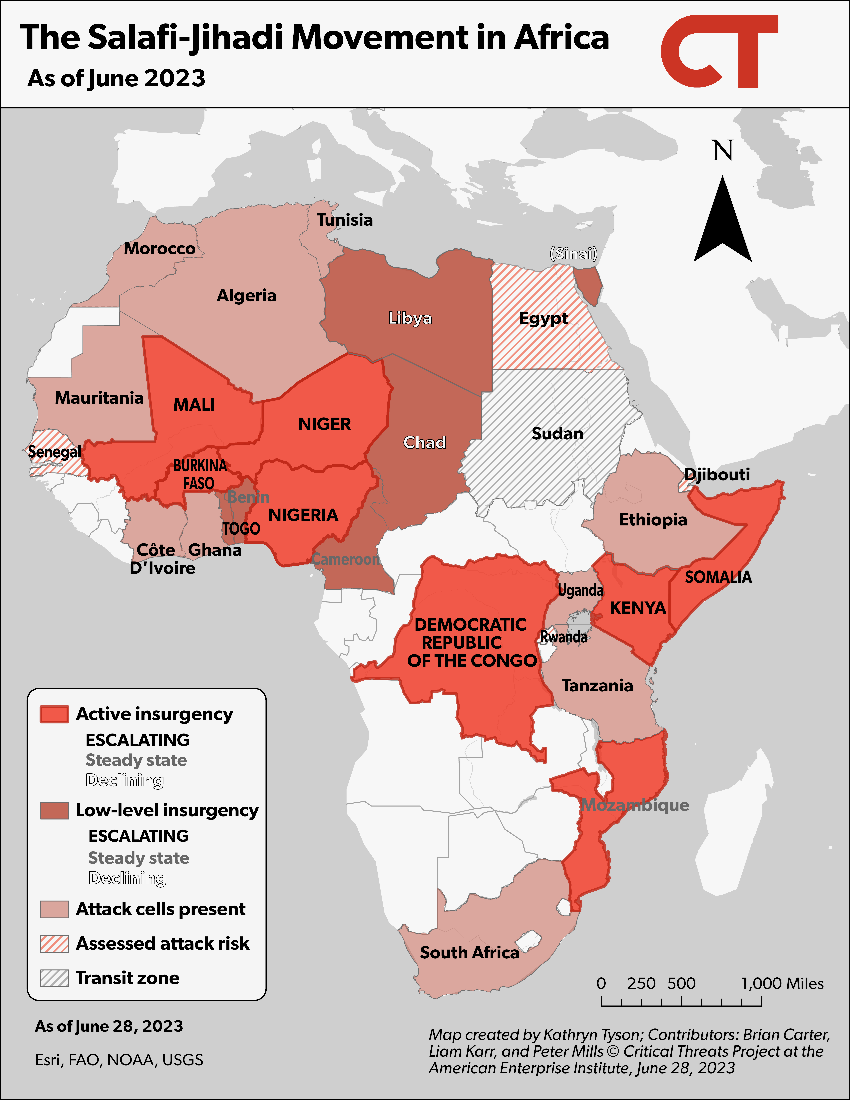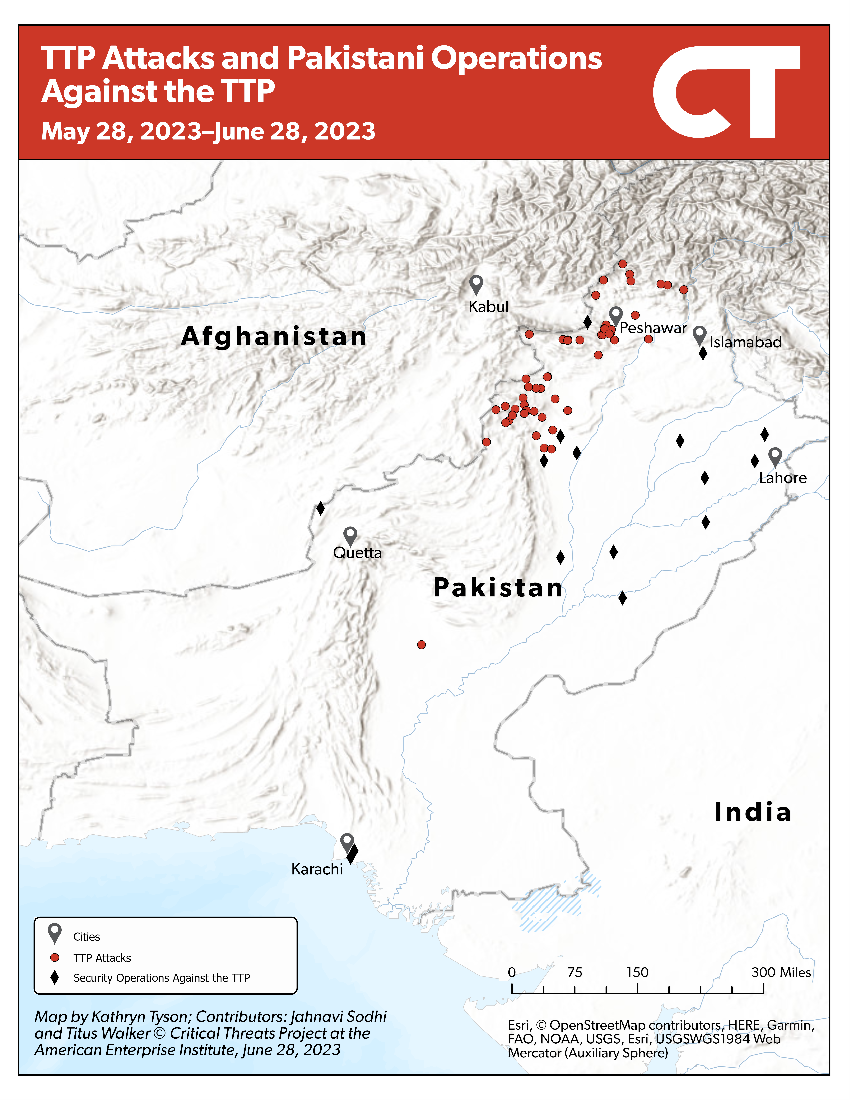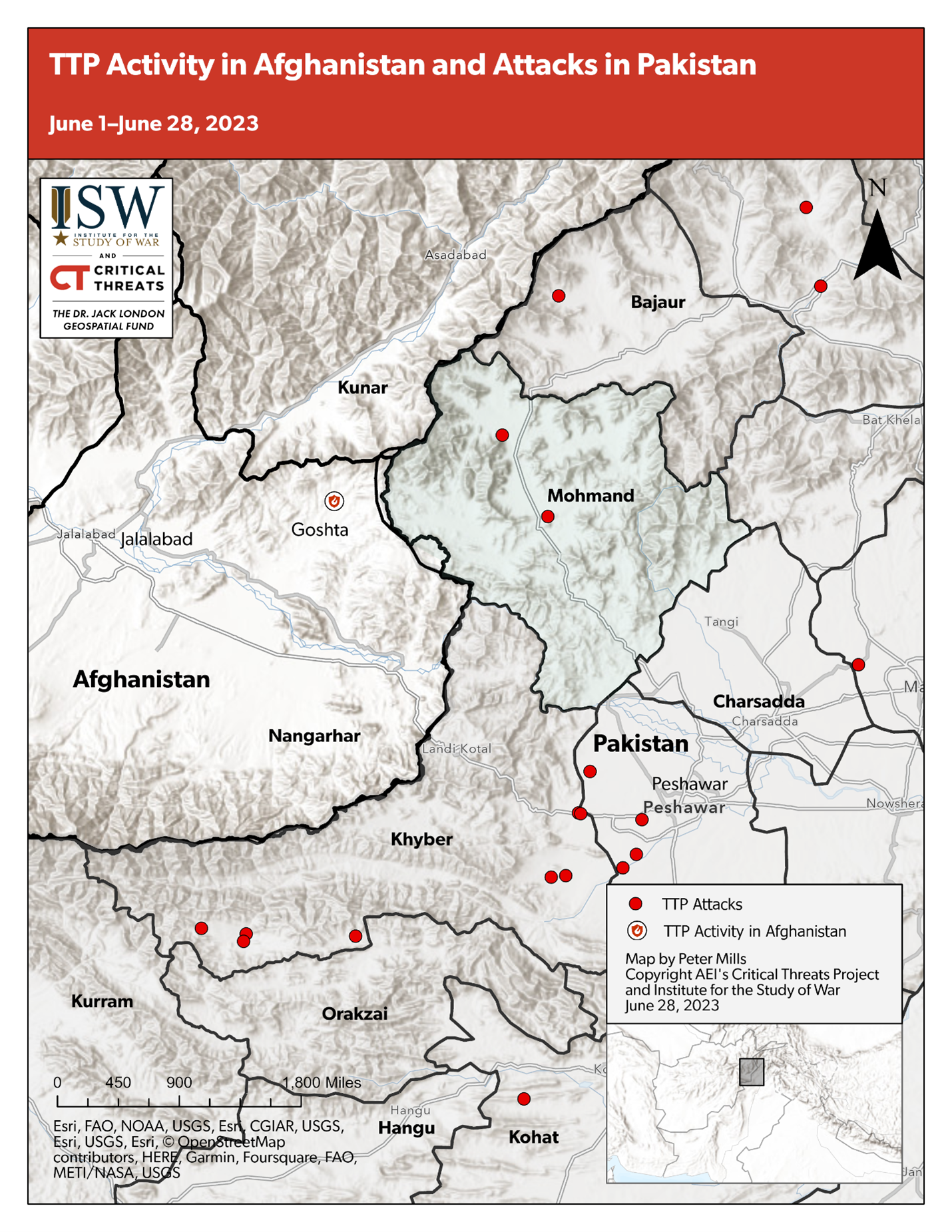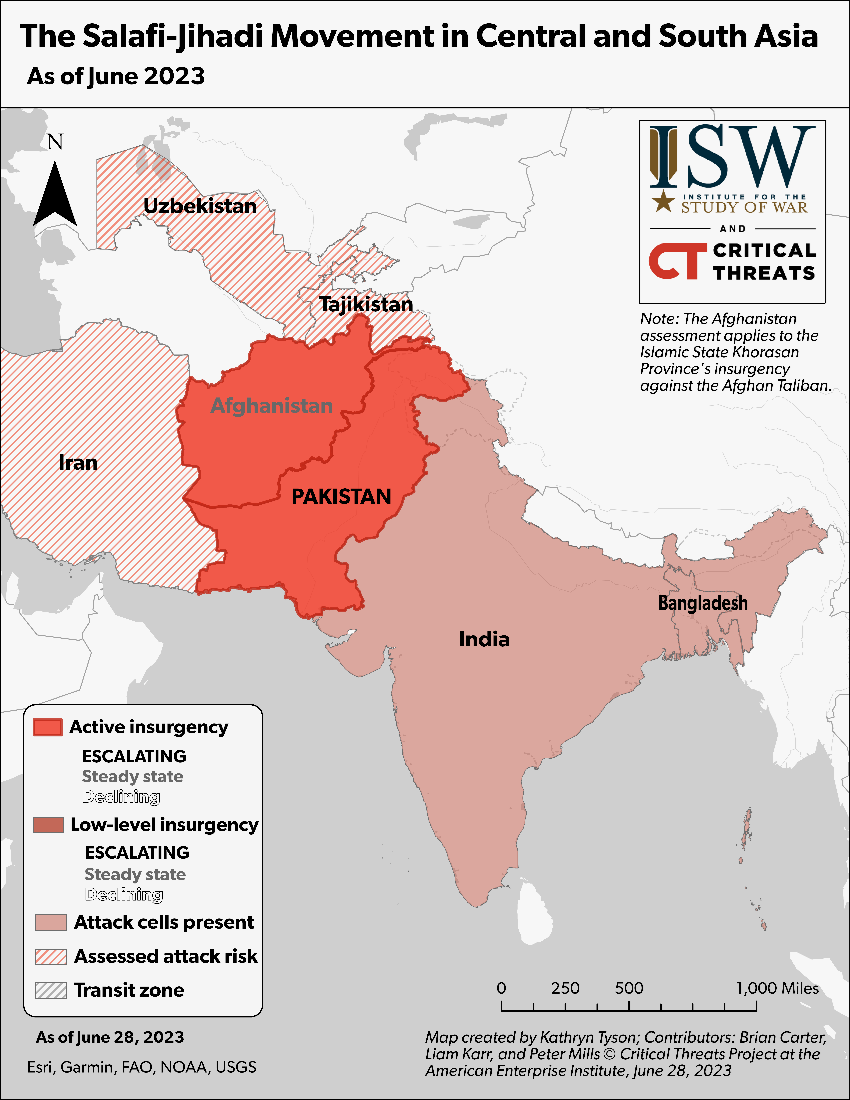 |
 |
Salafi-Jihadi Movement Weekly Update, June 28, 2023

Salafi-Jihadi Movement Weekly Update, June 28, 2023
Authors: Brian Carter, Kathryn Tyson, Liam Karr, Peter Mills, and Andie Parry
Data Cutoff: June 28, 2023, at 10 a.m.
Key Takeaways:
Iraq and Syria. ISIS has coerced greater support from the population and expanded attack zones along the Euphrates River, which will allow it to rebuild some capabilities over time. Iranian- and regime-backed activity inadvertently helps ISIS rebuild by undermining Syrian Democratic Forces (SDF) control. ISIS and Iranian- and regime-backed forces will be able to exploit the degradation of SDF control along the Euphrates to strengthen their capabilities.
Somalia. Al Shabaab is increasing the rate and severity of its attacks in northeastern Kenya and against Ethiopian forces in Somalia, likely to boost recruitment and local support in Ethiopia, Kenya, and Somalia. Al Shabaab may also intend to undermine the ability of Ethiopia and Kenya to effectively participate in an offensive against the group in southern Somalia.
Pakistan. The political crisis in Pakistan is exacerbating divisions within the Pakistani military. The Pakistani military fired three senior army commanders and disciplined 15 officers on June 26 over their actions during widespread protests in May. Divisions in the Pakistani military could weaken Pakistan's counter–Tehrik-e-Taliban Pakistan (TTP) operations as the TTP seeks to expand into new parts of the country.
Afghanistan. TTP is using support zones in Afghanistan to support attacks inside Pakistan. The Taliban government is unlikely to change its policies toward harboring foreign fighters in Afghanistan. The Taliban’s continuing failure to prevent the TTP from using Afghanistan to support its campaign against the Pakistani state will strain the relationship between the Taliban government and Pakistan.
Assessments:
Iraq and Syria. ISIS has coerced greater support from the population and expanded attack zones along both banks of the Euphrates River, which could present it an opportunity to rebuild sophisticated military capabilities. These capabilities, such as vehicle-borne improvised explosive devices and well-organized attack planning cells, would allow ISIS to generate forces by targeting prisons while also rolling back Syrian Democratic Forces (SDF) control of northeastern Syria.[1] ISIS has not created new support zones along the Euphrates River. The group does, however, have inconsistent access to local populations and key terrain it can use to move forces to and from northeastern Syria and collect intelligence on counter-ISIS forces. ISIS is already attempting to transition these contested areas into support zones. Locals in some areas north of Deir ez Zor city already refuse to move close to regime headquarters or engage with regime forces due to fear of attack.[2]
Figure 1. The Expansion of ISIS Zones Along the Euphrates
Source: Brian Carter.
Deep distrust between pro-regime forces, which sometimes causes clashes and tit-for-tat killings among units ostensibly countering ISIS, has undermined the regime’s ability to counter the group.[3] The regime and Iran also support anti-SDF sleeper cells in northeastern Syria that target the SDF and the United States.[4] This complements ISIS efforts to roll back SDF control of northeastern Syria.
This friction among pro-regime anti-ISIS forces and between pro-regime forces and the SDF prevents their coordination against ISIS. It also precludes deployments to and from areas without creating opportunities for ISIS to expand its influence. The regime and SDF frequently fight each other over control of smuggling along the Euphrates River, which discourages cooperation on countering ISIS movements across the river.[5] ISIS uses these movements to evade counterterrorism pressure from anti-ISIS forces.
Increased competition between pro-regime forces allowed ISIS to expand attack zones near Albu Kamal city, Syria, in May after it conducted zero attacks between October 2022 and February 2023.[6] ISIS similarly expanded its support zones north of Deir ez Zor city during March 2023, after competition over smuggling and local frustrations over lack of security against ISIS between the 4th Syrian Arab Army Division and local militias forced a poorly executed transfer of authority between the 4th Division and 17th Syrian Arab Army Division.[7] The poor transfer of authority allowed ISIS to intimidate the population. Syrian media outlet NPASyria reported that ISIS “controls the night” in Musayrib, a town north of Deir ez Zor affected by the transfer of authority.[8]
Figure 2. Reports of Iranian-Backed Sleeper Cell Recruitment Efforts
Source: Brian Carter and Institute for the Study of War.
ISIS has infiltrated pro-regime National Defense Forces (NDF) sleeper cells to resupply its cells and gain access to more-sophisticated systems, and it may infiltrate Iranian-backed sleeper cells in northeastern Syria for the same purpose. The regime has already established NDF sleeper cells in northeastern Syria, recruiting some of the cells’ members through the reconciliation process.[9] ISIS infiltrated these reconciliation efforts, which enabled the group to gain access to NDF sleeper cells’ weapon caches, which ISIS infiltrators use to resupply ISIS cells.[10] Local Syrian media reported that Iran recruited local Syrians through local intermediaries and “agents” for “sleeper cells” in SDF territory.[11] Iran has provided explosively formed penetrators (EFP) to some of the Syrians it has recruited for attacks against US forces in Syria.[12] Al Qaeda in Iraq gained access to EFPs after Iran smuggled them to its proxies in Iraq during the 2000s.[13]
The establishment of Iranian-backed sleeper cells to attack US forces in northeastern Syria could create opportunities for ISIS to strengthen itself there. The US counter-ISIS mission in Syria said in March 2023 that Iranian attacks against US forces result in “increased force protection requirements” and cause the mission to “reallocate [intelligence] assets to monitor [Iranian] threats.”[14] Counter-ISIS operations paused for 24 hours after Iranian-backed attacks against US forces killed a US contractor and wounded 25 US service members on March 23–24.[15] Iranian attacks against US forces in Syria that cause casualties could put the continuation of the counter-ISIS mission at risk, according to the US Defense Department’s inspector general.[16]
ISIS and regime-backed sleeper cells conduct attacks on the SDF in northeastern Syria, which undermine SDF control over the local population.[17] Limiting SDF control allows ISIS to create support among the population it can use to access resources required for more-sophisticated attack capabilities, such as vehicle-borne improvised explosive devices. Rolling back SDF control also creates unsecured areas from which Iranian-backed forces can launch attacks, such as Dhiban, Deir ez Zor province. ISIS cells forced SDF units to abandon Dhiban in 2022 and have coerced the population to elicit support.[18] Iranian-backed cells fired rockets targeting US forces from Dhiban in March 2023, highlighting the overlapping threat ISIS and Iran pose to US objectives in Syria.[19]
ISIS is likely to exploit the degradation of SDF control along the Euphrates to establish logistics infrastructure, such as safe houses, to rebuild the capabilities required for prison breaks. This would enable ISIS to continue rolling back SDF control. ISIS has previously launched vehicle-borne improvised explosive devices against Al Hol internally displaced person camp from support zones in Hasakah province.[20]
Iranian-backed forces are likely to exploit the degradation of SDF control along the Euphrates to recruit local Syrians to stage attacks and develop a network of safe houses from which they are better positioned to target US forces. A larger pro-Iran presence in northeastern Syria would allow Iranian-backed forces to collect better intelligence on US forces, thereby improving their ability to target US forces. Positioning sleeper cells closer to US forces helps improve accuracy by decreasing the distance rockets need to be launched toward their targets. Better intelligence on US forces would improve Iran-backed forces’ ability to effectively target US forces with EFPs. Iran has already begun recruiting individuals in northeastern Syria and plans to use EFPs against US forces there.[21]
Figure 3. The Salafi-Jihadi Movement in the Middle East
Source: Kathryn Tyson.
Somalia. Al Shabaab is increasing the rate and severity of its attacks in northeastern Kenya and against Ethiopian forces in Somalia, likely to boost recruitment and local support in Ethiopia, Kenya, and Somalia. The group has carried out at least 19 attacks in northeastern Kenya in June, after averaging only one attack per month since February 2023.[22] The group also conducted two multi–suicide vehicle-borne improvised explosive device attacks targeting Ethiopian bases in southwestern Somalia’s Gedo region on June 7 and 21. These were the first al Shabaab suicide attacks targeting Ethiopian forces since it attempted to invade Ethiopia in the summer of 2022.[23]
The attacks and al Shabaab’s rhetoric follow its pan-Somali narrative that brands Ethiopia and Kenya as foreign, Christian occupiers, which it uses to draw support from Somalis across the Horn of Africa.[24] This framing includes demanding the withdrawal of Ethiopian and Kenyan troops from Somalia and framing the Ethiopian and Kenyan governments as occupiers in the ethnically Somali areas of northeastern Kenya and Ethiopia’s Ogaden Region.[25]
Figure 4. Al Shabaab Increases Attacks in Northeastern Kenya and Against Ethiopian Forces in Somalia
Source: Liam Karr.
Al Shabaab may also intend to undermine the ability of Ethiopia and Kenya to effectively participate in an offensive against the group in southern Somalia. Somali officials announced in March that Djibouti, Ethiopia, and Kenya would send additional troops outside of the African Union mission to participate in counter–al Shabaab operations by June, but only Ethiopia has deployed troops.[26] The attacks and al Shabaab’s rhetoric aim to increase anti-Ethiopian and anti-Kenyan sentiment among the local population and erode the legitimacy of Ethiopian and Kenyan participation in an offensive against al Shabaab. Al Shabaab has not increased attacks against Djiboutian forces in Somalia because it lacks suitable havens to stage attacks in the areas of central Somalia where Djiboutian forces operate. This lack of havens is due to Somali counterinsurgency operations since the summer of 2022.[27]
Kenya’s response to the al Shabaab attacks will degrade the ability of Kenyan forces to escalate effective ground operations in Somalia. Kenya launched retaliatory air strikes in al Shabaab–controlled areas of southern Somalia on June 23 and 24.[28] Somali media and al Shabaab claimed the strikes caused civilian casualties, which would further exacerbate anti-Kenyan sentiment.[29] The attacks also adds demands on Kenyan forces that could prevent them from sending additional forces into Somalia. Al Shabaab has said that it will escalate attacks in Kenya in retaliation for future air strikes in Somalia, which would further strain the capacity of Kenyan forces.[30]
Figure 5. The Salafi-Jihadi Movement in Africa
Source: Kathryn Tyson.
Figure 6. TTP Attacks and Pakistani Operations Against the TTP
Source: Kathryn Tyson.
Pakistan. The political crisis in Pakistan is exacerbating divisions within the Pakistani military. Pakistan’s military fired three senior army commanders and disciplined 15 top officers on June 26 over their conduct during widespread protests that supported former Prime Minister Imran Khan in May.[31] The move represents the strongest actions the military has taken against its own members in decades.[32] The Pakistani military accused the commander and officers of failing to prevent protestors from ransacking garrisons, military installations, and other infrastructure.[33] The commanders fired included the commander of the Lahore-based IV Corps, Lt. Gen. Salman Fayyaz Ghani. Ghani was one of nine corps commanders in the Pakistani military, and he reported directly to the Pakistani Chief of Army Staff Asim Munir.
Divisions in the Pakistani military could weaken Pakistan’s counter–Tehrik-e-Taliban Pakistan (TTP) efforts as the TTP seeks to expand into new parts of the country. The TTP established two administrative governorates for the first time in Punjab province, where Lahore is located, on June 15.[34] The TTP also maintains attack cells across Punjab, and Pakistani security forces regularly carry out arrests of TTP militants in the region. Counterterrorism police typically conduct counter-TTP operations in Punjab, though Pakistan has launched coordinated campaigns between the military and police against the TTP in the area in the past. The IV Corps led a wide-scale counter-TTP campaign across Punjab in 2016 after a major TTP attack in Lahore.[35]
Figure 7. TTP Activity in Afghanistan and Attacks in Pakistan
Source: Peter Mills.
Afghanistan. The Taliban has not fulfilled its previously stated commitment to relocate TTP militants in Afghanistan away from the border with Pakistan, which will enable TTP militants to continue conducting cross-border attacks into Pakistan.[36] The Taliban government spokesman stated on June 13 that the Taliban planned to relocate an unspecified number of TTP militants from the border with Pakistan to northern Afghanistan.[37] However, the TTP issued a letter that rejects reports that the Taliban is relocating TTP fighters within Afghanistan. The group also instructed its commanders to resist efforts to relocate them.[38]
TTP attacks inside Pakistan tripled between 2020 and 2022 and increased terrorism-related deaths 120 percent in Pakistan in 2022.[39] On June 22, Pakistan rejected the Taliban government’s offer to mediate renewed talks between the TTP and Pakistan.[40] Prior negotiations collapsed in November 2022, leading to renewed TTP attacks. TTP safe havens in Afghanistan will support frequent TTP attacks in Pakistan, which will deteriorate relations between Pakistan and the Taliban government over time as the Taliban fails to address TTP safe havens.
The Taliban government’s recent rhetoric indicates the government is hardening its position and is unlikely to change policy toward harboring militants in Afghanistan. The Taliban continues to deny the presence of foreign militants in Afghanistan and is signaling it will not compromise in response to foreign pressure. Taliban government spokesmen Zabihullah Mujahid gave an interview with Afghan media on June 23 in which he reiterated Taliban denials that al Qaeda and Salafi-jihadi foreign fighters are present in Afghanistan, despite ample evidence to the contrary, and repeated international demands for the Taliban to expel these groups.[41] Mujahid characterized the Taliban government’s relations with the world as a “propaganda cold war,” which the Taliban would eventually win by outlasting foreign countries’ desire to change the Taliban.[42] Taliban Supreme Leader Hibatullah Akhundzada’s recent speeches on June 19 and 26 emphasized the Taliban government’s self-sufficiency and unwillingness to compromise when dealing with foreign countries.[43] Akhundzada also called for Taliban officials to maintain their “jihadist stance.”[44]
Two TTP commanders were injured when an improvised explosive device (IED) prematurely exploded in Ghosta District, Nangarhar Province, on June 26.[45] One of the injured is the commander for Hangu and Orakzai Districts in Pakistan, which suggests that the IEDs were to support TTP operations there or in neighboring Mohmand District, where the TTP also regularly conducts attacks.[46] CTP has not previously observed a TTP presence in Ghosta. The TTP may have established new support zones to assemble IEDs in Afghanistan that support operations in Pakistan.
Figure 8. The Salafi-Jihadi Movement in Central and South Asia
Source: Kathryn Tyson.
[1] https://www.criticalthreats.org/analysis/ending-the-us-presence-in-syria-could-cause-a-rapid-isis-reconstitution-and-threaten-core-us-national-security-interests
[2] https://npasyria dot com/151923
[3] https://deirezzor24 dot net/en/fourth-division-reinforcements-have-reached-al-bukamal-after-the-recent-skirmishes; https://nahermedia.net/%d8%a7%d8%ad%d8%aa%d9%82%d8%a7%d9%86-%d9%88%d8%aa%d9%87%d8%af%d9%8a%d8%af%d8%a7%d8%aa-%d9%85%d8%aa%d8%a8%d8%a7%d8%af%d9%84%d8%a9-%d8%a8%d9%8a%d9%86-%d8%a7%d9%84%d9%81%d8%b1%d9%82%d8%a9-%d8%a7%d9%84; https://www.syriahr dot com/%D9%84%D8%AE%D9%84%D8%A7%D9%81-%D8%A8%D9%8A%D9%86%D9%87%D9%85-%D8%B9%D9%84%D9%89-%D8%A7%D9%84%D8%AA%D9%80-%D9%80%D9%87%D9%80-%D9%80%D8%B1%D9%8A%D9%80-%D9%80%D8%A8-%D8%A3%D9%85%D9%80-%D9%80%D9%86/589344
[4] https://www.criticalthreats.org/analysis/iran-update-june-13-2023; https://www.crisisgroup.org/middle-east-north-africa/east-mediterranean-mena/syria/containing-resilient-isis-central-and-north
[5] https://www.mei.edu/publications/divided-syria-examination-stabilization-efforts-and-prospects-state-continuity; https://orient-news dot net/ar/news_show/203385
[6] Author’s research.
[7] https://www.criticalthreats.org/analysis/salafi-jihadi-movement-weekly-update-march-22-2023
[8] https://npasyria dot com/151923
[9] https://www.crisisgroup.org/middle-east-north-africa/east-mediterranean-mena/syria/containing-resilient-isis-central-and-north
[10] https://www.crisisgroup.org/middle-east-north-africa/east-mediterranean-mena/syria/containing-resilient-isis-central-and-north
[11] https://www.criticalthreats.org/analysis/iran-update-june-13-2023
[12] https://www.washingtonpost.com/world/2023/06/01/discord-leaks-iran-russia-syria
[13] https://www.understandingwar.org/sites/default/files/reports/Iran%20and%20Al-Qaeda%20in%20Iraq.pdf
[14] https://www.dodig.mil/Reports/Lead-Inspector-General-Reports/Article/3380832/lead-inspector-general-for-operation-inherent-resolve-i-quarterly-report-to-the/
[15] https://www.dodig.mil/Reports/Lead-Inspector-General-Reports/Article/3380832/lead-inspector-general-for-operation-inherent-resolve-i-quarterly-report-to-the/
[16] https://www.dodig.mil/Reports/Lead-Inspector-General-Reports/Article/3380832/lead-inspector-general-for-operation-inherent-resolve-i-quarterly-report-to-the/
[17] https://www.crisisgroup.org/middle-east-north-africa/east-mediterranean-mena/syria/containing-resilient-isis-central-and-north; https://cadmus.eui.eu/handle/1814/74418; https://deirezzor24 dot net/en/the-assad-regime-plans-to-carry-out-assassinations-in-the-sdf-areas; https://www.iswresearch.org/2020/08/anti-isis-coalition-begins-losing.html
[18] https://cadmus.eui.eu/handle/1814/74418; https://npasyria dot com/143361/; https://www.syriahr dot com/en/294325
[19] https://www.syriahr dot com/en/293074
[20] https://twitter.com/DeirEzzore/status/1608751217710333952; https://twitter.com/DeirEzzore/status/1608431882798088193; https://www.centcom.mil/MEDIA/STATEMENTS/Statements-View/Article/3167612/us-central-command-statement-on-thwarted-suicide-bomber-attack-near-um-fakik-vi/
[21] https://www.criticalthreats.org/analysis/iran-update-june-13-2023; https://www.washingtonpost.com/world/2023/06/01/discord-leaks-iran-russia-syria
[22] Author’s research.
[23] https://shabellemedia dot com/wararkii-ugu-dambeeyay-qaraxyo-iyo-weerar-toos-ah-oo-ka-dhacay-degmada-baardheere; https://www.caasimada dot net/dowladda-ethiopia-oo-war-ka-soo-saartay-weerarkii-doolow; https://www.criticalthreats.org/briefs/africa-file/africa-file-al-shabaab-attacks-ethiopia
[24] SITE Intelligence Group, “Shabaab Threatens Revenge for Kenya’s ‘Cowardly Attacks’ on Somali Civilians,” June 19, 2023, available by subscription at www.siteintelgroup.com; https://www.researchgate.net/publication/304987134_Al_Shabaab_in_Somalia_Between_Clan_and_Faith
[25] https://extremism.gwu.edu/sites/g/files/zaxdzs5746/files/Al-Shabaab-IMEP_Bacon_March-2022.pdf
[26] https://www.voanews.com/a/somalia-s-neighbors-to-send-additional-troops-to-fight-al-shabab-/6986748.html; https://www.garoweonline dot com/en/news/somalia/ethiopia-sends-non-atmis-troops-to-somalia-in-fight-against-al-shabaab; https://www.criticalthreats.org/analysis/salafi-jihadi-movement-weekly-update-june-14-2023#SOM20230614; https://www.criticalthreats.org/analysis/salafi-jihadi-movement-weekly-update-june-21-2023#Somalia20230621
[27] https://www.criticalthreats.org/briefs/africa-file/africa-file-clan-uprising-bolsters-anti-al-shabaab-offensive-in-central-somalia; https://atmis-au.org/military-component; https://www.criticalthreats.org/analysis/salafi-jihadi-movement-weekly-update-may-10-2023#Somalia20230510; https://www.crisisgroup.org/africa/horn-africa/somalia/b187-sustaining-gains-somalias-offensive-against-al-shabaab
[28] https://www.ftlsomalia dot com/one-person-injured-in-latest-airstrike-by-kenya-in-gedo
[29] https://shabellemedia dot com/faahfaahino-ka-soo-baxaya-duqeyn-culus-oo-ka-dhacday-gobolka-gedo; https://somaliguardian dot com/news/somalia-news/kenyas-military-carries-out-airstrikes-in-somalias-sakow-town
[30] SITE Intelligence Group, “Shabaab Threatens Revenge for Kenya's ‘Cowardly Attacks’ on Somali Civilians”
[31] https://apnews.com/article/pakistan-military-fires-officers-khan-graft-attack-06aef0dbcfc6c743787cbe6407178bac
[32] https://www.nytimes.com/2023/06/26/world/asia/pakistan-military-imran-khan.html
[33] https://theprint dot in/world/pakistan-army-goes-for-clean-up-sacks-former-lahore-corps-commander-2-others-over-9-may-violence/1643421
[34] https://www.criticalthreats.org/analysis/salafi-jihadi-movement-weekly-update-june-21-2023
[35] https://thediplomat.com/2016/05/the-pakistan-armys-curious-punjab-operation
[36] https://understandingwar.org/backgrounder/salafi-jihadi-movement-weekly-update-june-21-2023; https://www.pashtovoa.com/a/sources-say-a-pakistani-tribal-delegation-is-visiting-afghanistan-for-talks-with-ttp/7147889.html; https://www.bbc.com/persian/articles/cll0mg29y41o
[37] https://www.bbc.com/persian/articles/cll0mg29y41o
[38] https://twitter.com/Natsecjeff/status/1671967534755766277; https://twitter.com/ShabbirTuri/status/1671966123586363392
[39] https://ctc.westpoint.edu/the-tehrik-i-taliban-pakistan-after-the-talibans-afghanistan-takeover; https://www.voanews.com/a/pakistan-suffers-record-terror-related-deaths-afghanistan-registers-58-drop/7004410.html
[40] https://www.pashtovoa.com/a/sources-say-a-pakistani-tribal-delegation-is-visiting-afghanistan-for-talks-with-ttp/7147889.html
[41] https://twitter.com/AmuTelevision/status/1672252658374025216; https://www.longwarjournal.org/archives/2023/06/al-qaeda-actively-operating-training-camps-in-5-afghan-provinces.php; https://www.longwarjournal.org/archives/2023/06/afghan-taliban-and-al-qaeda-aiding-pakistani-talibans-insurgency.php; https://www.state.gov/the-death-of-ayman-al-zawahiri; https://www.bbc.com/news/world-asia-62387167
[42] https://twitter.com/AmuTelevision/status/1672252658374025216
[43] https://twitter.com/HurriyaAR/status/1670863622401294336; https://twitter.com/syedjamal_agha/status/1672893979057172480?s=20
[44] https://twitter.com/HurriyaAR/status/1670863622401294336
[45] https://twitter.com/bsarwary/status/1673203101954719744; https://twitter.com/ShabbirTuri/status/1673210772963622913; https://twitter.com/khorasandiary/status/1673222041045016576
[46] https://twitter.com/abdsayedd/status/1673213552495058947
